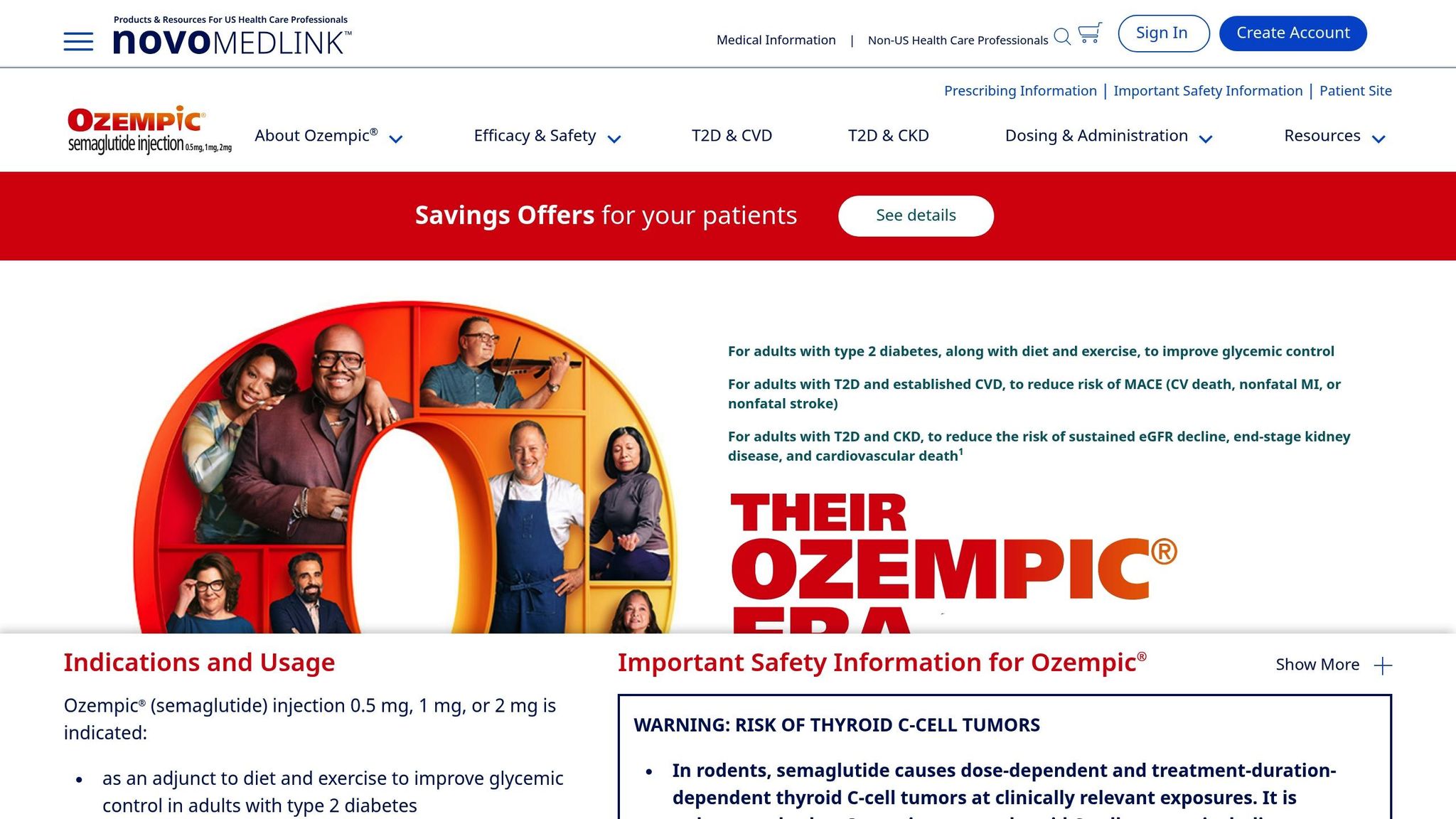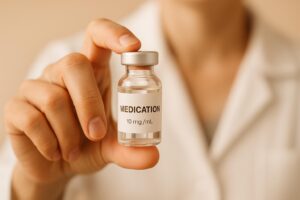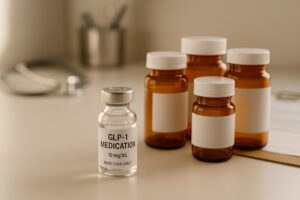Nausea and GLP-1 Medications: Solutions That Work

Nausea is a common side effect of GLP-1 medications like Semaglutide, Tirzepatide, Wegovy, and Ozempic, occurring in 40%–70% of users. It often happens during the first few weeks of treatment or after a dose increase but typically subsides within days. Managing nausea involves strategies like gradual dose increases (titration), dietary adjustments (smaller meals, bland foods), and natural remedies (ginger, peppermint). If symptoms persist, consult a doctor for potential dose modifications or anti-nausea medication. Personalized programs, such as those offered by TrimRX, can help tailor treatment and reduce side effects effectively.
Managing Nausea from Ozempic, Wegovy and Trulicity! | Dr. Dan Obesity Expert

How Dosage and Gradual Increases Help Control Nausea
Managing medication dosage carefully can significantly ease nausea by giving your body time to adjust. Instead of jumping straight to a high dose, healthcare providers often follow a "start low and go slow" strategy.
What Is Titration and How Does It Help?
Titration is the process of gradually increasing your medication dose over time. This approach helps reduce nausea, especially during the first 4-5 weeks of treatment or after any dose adjustments. By introducing the medication slowly, your body builds a tolerance, which can alleviate issues like delayed gastric emptying – a common cause of nausea.
Take semaglutide, for instance. Treatment typically begins at 0.25 mg for four weeks before increasing in steps to 0.5 mg, 1.0 mg, 1.7 mg, and eventually 2.4 mg. These increases happen at four-week intervals, but the timeline can be extended if needed. Similarly, tirzepatide doses are adjusted over 16 to 20 weeks to limit gastrointestinal discomfort. Titration schedules like these, combined with personalized plans, ensure the process is tailored to your tolerance level.
Why Custom Dosing Plans Are Important
Not every patient needs to reach the maximum recommended dose to see results. Many benefit from personalized dosing plans that balance effectiveness with fewer side effects. If nausea persists during dose increases, your healthcare provider might adjust your plan by extending the current dose for an additional 2-4 weeks, pausing further increases until symptoms improve, or temporarily lowering the dose. In some cases, a lower maintenance dose may be chosen if it achieves weight loss with minimal side effects.
The Importance of Medical Supervision
Custom dosing requires close monitoring by a healthcare professional to ensure adjustments are made safely and effectively. Medical supervision allows real-time changes to your treatment plan – whether that means extending, pausing, or reducing doses – to manage nausea based on your symptoms and overall progress.
TrimRX offers personalized weight loss programs that include ongoing medical supervision. Their healthcare providers create tailored dosing schedules for medications like Semaglutide, Tirzepatide, Mounjaro, Zepbound, Wegovy, and Ozempic. This individualized approach helps minimize side effects like nausea while supporting your long-term weight loss goals. With expert guidance, you can achieve results more comfortably and sustainably.
Practical Ways to Reduce Nausea
Managing nausea while taking GLP-1 medications often requires practical strategies that complement your treatment plan. These tips can help you feel more at ease during your journey.
Diet and Lifestyle Adjustments
Opt for smaller, more frequent meals. Eating five to six small meals throughout the day instead of three larger ones can ease digestion and prevent overloading your stomach.
Stick to bland, easy-to-digest foods. Plain crackers, white rice, toast, bananas, and applesauce are gentle on your stomach. Avoid greasy, spicy, or heavily seasoned dishes, as they can worsen nausea. Cold foods might also feel better since they produce fewer odors that could trigger discomfort.
Stay upright after eating. Spend 30 to 60 minutes in an upright position post-meal to aid digestion. Lying down too soon can slow this process and increase discomfort.
Slow down and chew thoroughly. Since GLP-1 medications naturally slow gastric emptying, eating slowly and chewing your food well can align with the medication’s effects, making digestion smoother.
Limit fluids during meals. Drinking large amounts of liquid while eating can leave you feeling overly full and more nauseated. Instead, sip small amounts during meals and hydrate between them.
These simple changes can make a noticeable difference in managing nausea.
Hydration and Natural Remedies
Hydration and natural approaches can also play a role in reducing nausea. Drink fluids between meals rather than with them to stay hydrated without burdening your stomach. Room-temperature or slightly cool water is often more soothing than ice-cold drinks.
Ginger can be a natural aid. Ginger tea, chews, or crystallized ginger may help ease stomach upset. Start with small amounts to see how your body reacts.
Peppermint tea or capsules may also help calm your stomach, though some people find mint too overpowering when feeling unwell.
Fresh air and deep breathing can provide quick relief when nausea strikes unexpectedly. Step outside or open a window, and take slow, deep breaths through your nose to help settle your system.
Adjust medication timing. Some people find taking their GLP-1 medication with food reduces nausea, while others do better on an empty stomach. Work with your healthcare provider to determine the best timing for you.
Knowing When to Call Your Doctor
If these strategies don’t alleviate your symptoms, it’s important to seek medical advice.
Persistent nausea lasting more than a few days should be discussed with your doctor, as they may need to adjust your dosage or provide additional support.
Severe nausea with vomiting requires immediate attention. This could lead to dehydration or indicate that your dose is too high for your tolerance level.
Watch for signs of gastroparesis. Symptoms like ongoing bloating, feeling full after eating very little, vomiting undigested food hours later, or severe abdominal pain need prompt medical evaluation.
Report unusual or worsening symptoms. Severe abdominal pain, persistent heartburn, or changes in bowel habits could signal complications that require attention.
If lifestyle changes and natural remedies aren’t enough, your doctor might recommend prescription anti-nausea medications like ondansetron (Zofran) or metoclopramide. These can be especially helpful during the first few weeks of treatment or after a dose increase.
sbb-itb-e2779c3
Personalized Support for Managing Nausea
When it comes to managing nausea, a personalized approach can make all the difference. TrimRX goes beyond basic dosage strategies by offering tailored programs that include custom dosing, regular follow-ups, and expert advice to help minimize GLP-1-related side effects like nausea.
How TrimRX Programs May Address Nausea

TrimRX providers carefully adjust dosing schedules based on your unique response to treatment. By monitoring your progress and making timely adjustments, they aim to reduce nausea and other side effects. Regular check-ins ensure that any issues are addressed promptly, creating a more seamless treatment experience. This personalized care builds on the dosage strategies mentioned earlier, ensuring your treatment plan evolves to meet your needs.
Other Benefits of TrimRX Programs
TrimRX’s support doesn’t stop at managing nausea. Their program is designed to improve overall treatment adherence and convenience. With free medication delivery, you can stay on track with your dosing schedule without the hassle. Plus, TrimRX offers a variety of GLP-1 medication options, including oral and injectable Semaglutide, as well as combinations like Tirzepatide and trusted brand names such as Ozempic, Mounjaro, Zepbound, and Wegovy.
To promote overall wellness, TrimRX also provides nutritional supplements. The GLP-1 Daily Support supplement features ingredients like Alpha Lipoic Acid, Berberine, Chromium, and a multivitamin blend. Additionally, their Weight Loss Boost supplement is packed with science-based ingredients aimed at enhancing fat burning and supporting long-term weight loss.
Comparing Different Ways to Manage Nausea
This section takes a closer look at various methods for managing GLP-1-related nausea, weighing their benefits, drawbacks, and how quickly they work.
Side-by-Side Comparison of Nausea Management Methods
The effectiveness of each approach can vary depending on how it’s implemented and individual responses. Here’s a breakdown of the main options:
| Method | Effectiveness | Time to See Results | Pros | Cons |
|---|---|---|---|---|
| Slow Dose Increases (Titration) | High | 2-4 weeks | Gradual adjustment reduces shock; medically recommended; allows adaptation | Progress takes longer; some nausea may still occur; requires patience |
| Diet Modifications | Moderate to High | 1-2 weeks | Natural and health-focused; can complement other methods | Demands lifestyle changes; may not tackle severe nausea; needs consistency |
| Natural Remedies | Moderate | Days to 1 week | Quick relief for mild symptoms; easily available; few side effects | Limited for severe cases; relief is temporary; not effective for everyone |
| Personalized Medical Programs | Very High | 1-3 weeks | Tailored care; professional oversight; ongoing support | Requires medical involvement; may be more expensive; needs regular follow-ups |
This comparison complements earlier discussions about dosing strategies, offering a clear view of each method’s benefits and limitations.
For those new to GLP-1 medications, starting with gradual dose increases paired with dietary adjustments often works well. If nausea is already present, natural remedies can provide fast relief while waiting for dosage changes to take effect.
For mild symptoms, options like ginger tea or eating smaller, more frequent meals can help. However, persistent or severe nausea may require more structured solutions, such as adjusting the dose or enrolling in a personalized medical program.
While natural remedies are affordable and easy to access, personalized programs may involve higher costs but often deliver longer-term results. Ultimately, combining approaches can provide the best path to relief.
Managing Nausea for Weight Loss Success
Dealing with nausea is an important part of staying on track with your weight loss journey. If nausea becomes too severe, it can discourage continued treatment, potentially impacting long-term progress.
One of the best ways to tackle this is by working closely with a medical professional and making thoughtful dose adjustments. Since gastrointestinal side effects affect anywhere from 40% to 70% of patients, starting with a lower dose gives your body time to adapt, which can help minimize nausea.
TrimRX takes this approach a step further by offering personalized dosing and unlimited medical check-ins to address nausea effectively. By tailoring doses to suit your needs, they aim to strike the right balance between achieving results and keeping side effects manageable. With expert support, you can safely adjust your treatment plan and stay focused on reaching your weight loss goals.
FAQs
How do I know if my nausea from GLP-1 medications is normal or something more serious?
Mild nausea is a typical side effect of GLP-1 receptor agonist medications and usually subsides as your body gets used to the treatment. That said, if the nausea lingers or starts to disrupt your daily routine, it’s something that shouldn’t be ignored.
If you notice severe or ongoing symptoms like vomiting, abdominal bloating, pain, or feeling full unusually fast, reach out to your healthcare provider right away. These could signal a more serious condition that needs medical evaluation. Your provider might suggest adjusting your dosage or making dietary changes to ease the discomfort, offering tailored advice to help manage the symptoms effectively.
What dietary tips can help reduce nausea when starting GLP-1 medications?
To help manage nausea when starting GLP-1 medications, try eating smaller, more frequent meals spread throughout the day. Opt for foods that are easier on your stomach, like lean proteins, whole grains, and vegetables high in fiber. Steer clear of foods that are greasy, sugary, spicy, or known to cause gas, as well as alcohol, which can make symptoms worse.
Staying hydrated is equally important – sip on water or clear fluids regularly, but avoid drinking large amounts during meals. If the nausea continues, reach out to your healthcare provider. They can offer advice or adjust your dosage to better manage the side effects.
How does the TrimRX program help manage nausea caused by GLP-1 medications?
TrimRX offers a tailored solution to help manage side effects, such as nausea, that can come with GLP-1 receptor agonist medications. By customizing dosage adjustments to fit your specific needs and providing continuous support, they aim to reduce discomfort while maintaining the effectiveness of the treatment.
The program includes access to expert consultations, personalized prescriptions, and ongoing guidance to address side effects quickly. This approach makes the weight loss process smoother and easier to stick with over time.
Related Blog Posts

Transforming Lives, One Step at a Time
Keep reading
Ultimate Guide to Semaglutide Dose Customization
This guide explores semaglutide dosing for diabetes and weight loss, emphasizing personalized adjustments for optimal results.
6 Common Drug Interactions with GLP-1 Medications
Learn about six common drug interactions with GLP-1 medications and how to manage potential risks for safe treatment.
Mounjaro Insurance Coverage: What to Know
Learn how insurance coverage for Mounjaro varies based on diabetes treatment and weight loss, along with tips for approval and cost-saving options.
Semaglutide vs. Tirzepatide: Max Dose
Explore the differences between two weight loss medications, their maximum doses, effectiveness, and safety profiles for better health outcomes.
GLP-1 Diet Plan: 7-Day Meal Guide
Learn how to effectively pair GLP-1 medications with nutritious meal planning for weight loss, improved digestion, and stable blood sugar.
5 Signs GLP-1 Medication Is Working for You
Learn the key signs that indicate your GLP-1 medication is effectively aiding weight loss, appetite control, and blood sugar management.
Plateau Problems: Restarting Weight Loss
Stalled weight loss on GLP-1 medications is common but manageable. Explore strategies to break through plateaus and regain momentum.
Body Fat Percentage Estimator – Know Your Stats
Estimate your body fat percentage in seconds with our free tool. Just input your height, weight, and more for instant results. Try it now!
Wegovy vs Ozempic: Complete Comparison
Explore the differences between two popular medications for weight management and diabetes, including dosing, side effects, and effectiveness.









